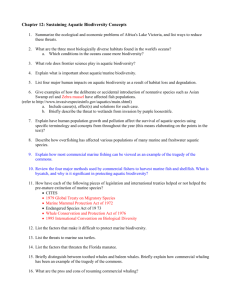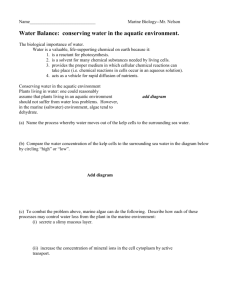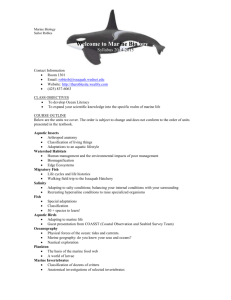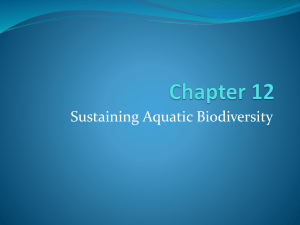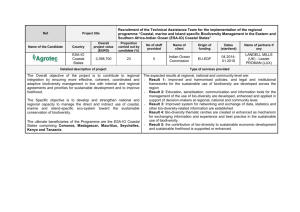12 SUSTAINING AQUATIC BIODIVERSITY
advertisement
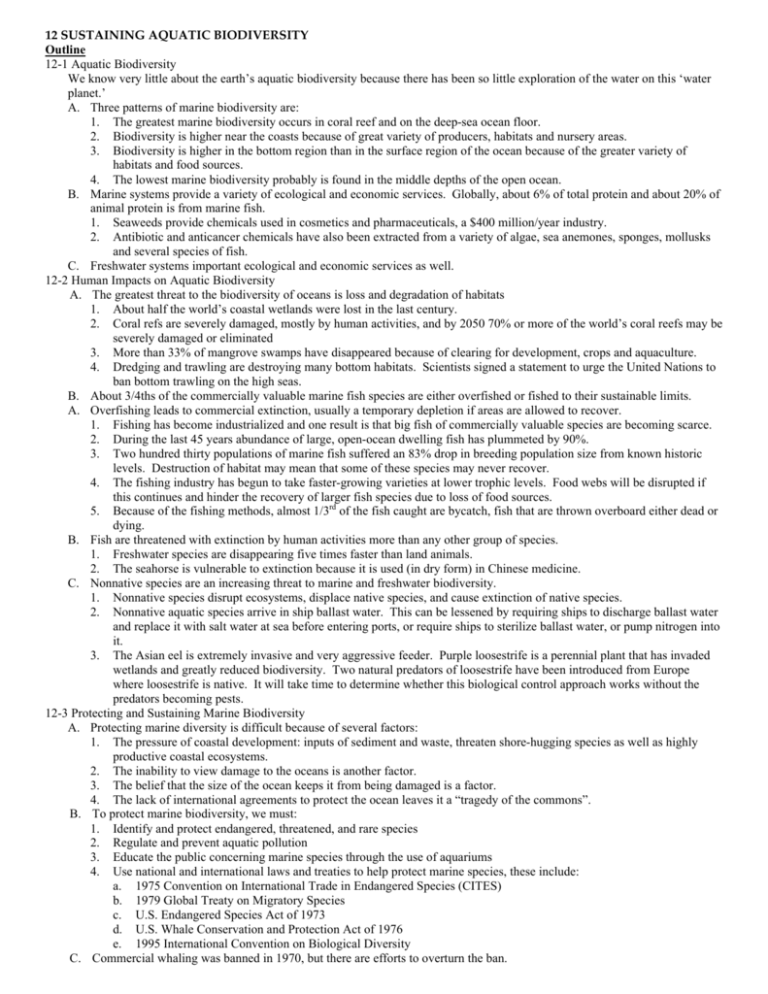
12 SUSTAINING AQUATIC BIODIVERSITY Outline 12-1 Aquatic Biodiversity We know very little about the earth’s aquatic biodiversity because there has been so little exploration of the water on this ‘water planet.’ A. Three patterns of marine biodiversity are: 1. The greatest marine biodiversity occurs in coral reef and on the deep-sea ocean floor. 2. Biodiversity is higher near the coasts because of great variety of producers, habitats and nursery areas. 3. Biodiversity is higher in the bottom region than in the surface region of the ocean because of the greater variety of habitats and food sources. 4. The lowest marine biodiversity probably is found in the middle depths of the open ocean. B. Marine systems provide a variety of ecological and economic services. Globally, about 6% of total protein and about 20% of animal protein is from marine fish. 1. Seaweeds provide chemicals used in cosmetics and pharmaceuticals, a $400 million/year industry. 2. Antibiotic and anticancer chemicals have also been extracted from a variety of algae, sea anemones, sponges, mollusks and several species of fish. C. Freshwater systems important ecological and economic services as well. 12-2 Human Impacts on Aquatic Biodiversity A. The greatest threat to the biodiversity of oceans is loss and degradation of habitats 1. About half the world’s coastal wetlands were lost in the last century. 2. Coral refs are severely damaged, mostly by human activities, and by 2050 70% or more of the world’s coral reefs may be severely damaged or eliminated 3. More than 33% of mangrove swamps have disappeared because of clearing for development, crops and aquaculture. 4. Dredging and trawling are destroying many bottom habitats. Scientists signed a statement to urge the United Nations to ban bottom trawling on the high seas. B. About 3/4ths of the commercially valuable marine fish species are either overfished or fished to their sustainable limits. A. Overfishing leads to commercial extinction, usually a temporary depletion if areas are allowed to recover. 1. Fishing has become industrialized and one result is that big fish of commercially valuable species are becoming scarce. 2. During the last 45 years abundance of large, open-ocean dwelling fish has plummeted by 90%. 3. Two hundred thirty populations of marine fish suffered an 83% drop in breeding population size from known historic levels. Destruction of habitat may mean that some of these species may never recover. 4. The fishing industry has begun to take faster-growing varieties at lower trophic levels. Food webs will be disrupted if this continues and hinder the recovery of larger fish species due to loss of food sources. 5. Because of the fishing methods, almost 1/3rd of the fish caught are bycatch, fish that are thrown overboard either dead or dying. B. Fish are threatened with extinction by human activities more than any other group of species. 1. Freshwater species are disappearing five times faster than land animals. 2. The seahorse is vulnerable to extinction because it is used (in dry form) in Chinese medicine. C. Nonnative species are an increasing threat to marine and freshwater biodiversity. 1. Nonnative species disrupt ecosystems, displace native species, and cause extinction of native species. 2. Nonnative aquatic species arrive in ship ballast water. This can be lessened by requiring ships to discharge ballast water and replace it with salt water at sea before entering ports, or require ships to sterilize ballast water, or pump nitrogen into it. 3. The Asian eel is extremely invasive and very aggressive feeder. Purple loosestrife is a perennial plant that has invaded wetlands and greatly reduced biodiversity. Two natural predators of loosestrife have been introduced from Europe where loosestrife is native. It will take time to determine whether this biological control approach works without the predators becoming pests. 12-3 Protecting and Sustaining Marine Biodiversity A. Protecting marine diversity is difficult because of several factors: 1. The pressure of coastal development: inputs of sediment and waste, threaten shore-hugging species as well as highly productive coastal ecosystems. 2. The inability to view damage to the oceans is another factor. 3. The belief that the size of the ocean keeps it from being damaged is a factor. 4. The lack of international agreements to protect the ocean leaves it a “tragedy of the commons”. B. To protect marine biodiversity, we must: 1. Identify and protect endangered, threatened, and rare species 2. Regulate and prevent aquatic pollution 3. Educate the public concerning marine species through the use of aquariums 4. Use national and international laws and treaties to help protect marine species, these include: a. 1975 Convention on International Trade in Endangered Species (CITES) b. 1979 Global Treaty on Migratory Species c. U.S. Endangered Species Act of 1973 d. U.S. Whale Conservation and Protection Act of 1976 e. 1995 International Convention on Biological Diversity C. Commercial whaling was banned in 1970, but there are efforts to overturn the ban. 1. 2. Cetaceans are marine mammals, classified into two major groups: toothed whales and baleen whales. Whales are air breathing and must come to the surface to breathe, this makes them easy targets since they are large mammals and equipment for hunting them is so sophisticated. 3. Eight of the 11 major species of whale have been driven to the point of commercial extinction, and the blue whale to the edge of biological extinction. 4. The International Whaling Commission (IWCC) was established in 1946. It set quotas to prevent overharvesting. 5. This did not work well for two reasons: a. Quotas were based on inadequate data or ignored b. There were no powers of enforcement. 6. The U.S. banned all whaling in 1970 and banned all imports of whale products. A moratorium on whaling was imposed by governments of many nonwhaling countries in 1986. This has dropped the number of whales killed from 42,480 in 1970 to about 1,200 in 2004. 7. Japan, Norway, Iceland, Russia and some small island countries continue to work to overthrow the IWC ban on commercial whaling and reverse the ban on purchase and sale of whale products. 8. Conservationists feel that whaling should not be resumed since estimates of recovery may be too high and these mammals should be protected for ethical reasons. This could also lead to widespread harvests of most whale species and weaken international sanctions. The controversy continues. 9. The blue whale has fewer than 10,000 in its present population and may never recover due to slow sexual maturation (25 years), low birth rate (1 calf every 2-5 years) and despite protection and nonhunting since 1964 biologists fear there are too few whales remaining for them to recover. D. Nations have established marine sanctuaries, but many are only partially protected. 1. Nations have sovereignty over waters and seabed up to 12 miles offshore. The Exclusive Economic Zone (EEZ) extends out 200 mile from shore, but too often these areas have not been regulated to sustain fish harvest, rather, they have been overfished. 2. The World Conservation Union helped establish a global system of marine protected areas (MPAs). 3. There are about 90 marine reserves in the world; Australia has established the largest one. 4. Studies show that within as few as two years after establishing a reserve the fish are larger, reproduce more often and are in greater variety than previously. 5. A group of marine biologists have called for the protection of 20% of the ocean’s surface by 2020. 6. Marine biologist Elliott Norse proposed establishment of moveable marine reserves that move with the animals as they migrate in the ocean. E. Integrated coastal management is a community-based effort to develop and use coastal resources more sustainably. 1. The idea is to find cost-effective, adaptable solutions to preserve biodiversity while meeting economic and social needs. This uses the principles of adaptive ecosystem management. 2. The U.S. has 90 coastal counties working to establish management systems, but less than 20 have been implemented. F. We need to greatly increase the use of reconciliation ecology in protecting, sustaining, and restoring aquatic systems. G. The role of reconciliation ecology needs to be expanded. Several examples are given here such as the dredging of a canal for the Turkey Point, Fla. Electric power plant. A mangrove swamp developed on the bank dredge and later alligators appeared in the canal. 12-4 Managing and Sustaining Marine Fisheries A. Overfishing is a serious threat to biodiversity in coastal waters and to some marine species of open-ocean waters. B. One way to prevent overfishing is to develop better ways to project fish populations. The maximum sustained yield mathematical model is used, but indications are that it has hastened the collapse of most commercially valuable stocks for several reasons: 1. Populations and growth rates are difficult to measure 2. Sizes of fish stocks are often based on unreliable/underreported catch figures 3. Harvesting a species at maximum sustainable yield can affect other target and nontarget fish species 4. Fishing quotas are difficult to enforce C. Optimum sustained yield is a concept that takes into account interactions with other species and allows more room for error. Another approach is multi-species management of a number of interaction species, which accounts for competition and predator-prey interactions. D. There has been limited management of several large marine systems, such as the Mediterranean Sea. E. Many fisheries scientists and environmentalists are interested in using the precautionary principle for management of fisheries and marine systems. F. Some fishing communities regulate fish harvests on their own and others work with the government to regulate them. Influx of large modern fishing boats and fleets has weakened the ability to regulate and sustain local fisheries. Many community management systems are now co-managed, where community and government work together to manage fisheries. 1. Central government sets quotas for various species, divides the quotas among communities 2. Government may also limit fishing seasons and regulate gear to be used. 3. Each community then allocates its quota among members. G. Individual transfer quotas (ITQs) are assigned to each fisherman, and these can then be bought, sold or leased, like private property. This has resulted in some reduction of overfishing, but it is hard to enforce, and wasteful bycatch has not been reduced. H. Four problems with the ITQ system are: 1. It transfers public ownership to private fishers, but still makes the public responsible for cost of management and enforcement. Remedy this by collecting fees form quota holders to pay costs of enforcement. 2. Small fishing vessels and companies may be squeezed out if they can’t afford to buy ITQs from others 3. Poaching may increase. Remedy this by strict record keeping and observers on all vessels with quotas. 4. Fishing quotas often set too high, so leave 10-50% of the estimated MSY as a buffer to protect the fishery from decline. 12-5 Protecting, Sustaining, and Restoring Wetlands A. Coastal and inland wetlands are important reservoirs of aquatic biodiversity; they provide ecological and economic services. B. A law that requires a permit to fill or deposit dredges into wetlands has cut wetland loss by 80% between 1969 and 2002. C. A study by the National Academy of Sciences found that mitigation banking, the destruction of a wetland as long as an equal area of the same type is created or restored does not work very well. These projects often fail to meet the standards set for them. D. An ambitious restoration project is trying to undo the human damage in South Florida’s Everglades. The natural Everglades is half its original size and is drying out, leaving it vulnerable to fire and invasion by nonnative species 1. Everglades National Park was set up in the lower part of the Everglades, but water didn’t flow into it and human activity caused disturbances. 2. Ninety percent of the wading birds are gone and other vertebrates are reduced in number 75-95%. 3. Florida Bay has become saltier and warmer due to lack of water flow from the Everglades and the Kissimmee River. 4. Loss of water flow and input from crop fields and cities has caused large algal blooms on the bay. These blooms threaten coral reefs, hinder diving, fishing and the tourist industry of the bay and the Florida Keys. E. The U.S. Army Corp of Engineers has begun a restoration project funded by the state and the federal government to restore the meandering river and flow of water to the Everglades. It has several ambitious goals: 1. Restore curving flow of more than half of the Kissimmee River. 2. Remove 250 miles of canals and levees south of Lake Okeechobee. 3. Buy 93 square miles of farmland and allow it to flood to create artificial marshes. 4. Create a network of artificial marshes. 5. Create 18 large reservoirs to ensure water for south Florida’s present and future population and the lower Everglades. 6. Build new canals, reservoirs, and pumping stations to capture and return to the Everglades 80% of the water flowing out to sea. F. There are indications that the plans are unraveling. Indications are that the restoration project may be secondary to providing water for agriculture. 12-6 Protecting, Sustaining and Restoring Lakes and Rivers Invasions by nonnative species have upset the ecological functioning of the Great Lakes for decades with more invaders coming. A. At least 162 nonnative species have invaded the Great Lakes since the 1920’s. B. Measures have been taken to control a number of these species. 1. Sea lampreys are one of the biggest threats and have depleted a number of the sport fish species in the lakes. 2. Zebra mussels were brought into the lakes in ballast and have become very aggressive pests since they have no known natural enemies. They have displaced native mussel species, clogged pipes, piers, and fouled beaches and have spread to other parts of the U.S. C. Rivers/streams are important ecological and economic resources, but they can be degraded by overfishing, pollution, dams and water withdrawal. D. The Columbia River has been altered by 119 dams and withdrawal of water for agriculture. 1. Salmon are migratory fish that breed in the upper reaches of the river and its tributaries. They need free flowing water to return, spawn, and lay eggs where they hatched. 2. Salmon benefit the nearby forest as fertilizer as bears eat and discard many carcasses on the forest floor. Trees grow up to three times faster along streams with salmon than along streams without salmon. 3. Dams on the river, overfishing in the Pacific Ocean for salmon, destruction of spawning grounds by sediment, and water withdrawal has resulted in a 94% drop of wild Pacific salmon and nine species of Pacific Northwest salmon are endangered or threatened. 4. Lack of trees along the stream banks of spawning rivers makes the water too warm for egg survival. 5. Commercial fishing modified the salmon’s natural cycle. Eggs and young are raised in hatcheries; escape of these ranch salmon and interbreeding with wild salmon could reduce genetic diversity. 6. The Northwest Power Act was passed in 1980. Its two main goals of meeting the electricity needs of the region and restoring salmon and other fish populations often conflict. 7. People are working together to try to solve the conflicts in this large-scale reconciliation project. 8. Critics say that the wild salmon populations are stable in Alaska, so we shouldn’t worry about the wild salmon of the Pacific Northwest. E. Sustainable management of freshwater fish involves encouraging populations of commercial/sport fish species, prevents overfishing, and reduces or eliminated less desirable fish populations. 1. Regulate fishing seasons and the number and size of fish taken. 2. Improve habitats, breed genetically resistant fish varieties, and judicious use of antibiotics and disinfectants to control predators, parasites and diseases are methods suggested. 3. Some individuals have worked to restore degraded streams. F. The national Wild and Scenic Rivers Act was passed in 1968 to protect rivers and river segments with outstanding scenic, recreational, geological, wildlife, historical or cultural values. G. Congress established a three-tiered classification scheme: 1. Wild rivers are relatively inaccessible, they are not permitted to be widened, straightened, dredges, filled or dammed. 2. Scenic rivers are free from dams, mostly undeveloped, of great scenic value, and accessible in some places by roads. 3. Recreational rivers are readily accessible by roads and may have some dams or development along their shores. 4. Only 0.2% of the 3.5 million miles of rivers are protected under the Act, and 17% of the total river length has dams and reservoirs on them. 5. Environmentalists want to add 1,500 additional river segments for a total of 2% of the total river systems. There is opposition from several groups. Threats to aquatic biodiversity are real and growing. We must greatly increase research and expand efforts to protect and restore aquatic biodiversity and promote integrated ecological management. Summary 1. Aquatic biodiversity refers to the composition of plants and animals in the fresh and salt waters of the planet. Its economic importance lies in the 6% of protein and 20% of animal protein taken from the water. Chemicals from aquatic plants and animals amount to $400 million per year. Many medicines have been developed from sea organisms: sponges, anemones, puffer fish, porcupine fish, seaweeds, etc. The waters are used for extensive recreational activities, not to mention commercial transportation. 2. Human activities are undermining aquatic biodiversity by destroying and degrading coastal wetlands, coral reefs, mangroves and the ocean bottom. 3. We can protect and sustain marine biodiversity by using laws, international treaties, and education. We must identify and protect species that are endangered and/or threatened. This entails cleaning up aquatic environments, as well as inventing fishing methods which do not destroy animals and birds inadvertently caught in fishing nets. Poaching and illegal harvesting of marine creatures must also be eliminated. Public aquariums can, also, educate the public about protecting marine animals and birds. Marine sanctuaries and coastal management can protect aquatic environments as well as their creatures. 4. The world’s marine fisheries can be managed by setting catch limits below the maximum sustained yield limits, by reducing/eliminating fishing subsidies and by charging fees for fishing in publicly owned offshore waters. Some areas can be protected from any kind of fishing; there should be more marine protected areas and more integration of coastal management practices. Develop net-escape devices for fishing boats. Restriction of coastal locations for fish farm, control of pollution, and decreasing the pollution of ship ballast water into the sea will all protect marine fisheries. Multispecies management of large marine systems offers hope for conserving marine resources and for renewing those resources. 5. Wetlands can be protected, sustained, and restored by government regulations which prevent wetland loss. Destroyed wetlands can, also, be restored and adequately monitored for their protection. Development can be kept away from wetland areas and control of nonnative species needs to be instituted to prevent invasion into wetlands. 6. Freshwater fisheries, lakes and rivers can be protected, sustained, and even restored by building and protecting populations of desirable species, by prevention of overfishing, and by decreasing populations of less desirable species. Laws must be enacted and enforcers of these laws must be funded to protect scenic rivers; they must be protected from development and dam construction projects.
